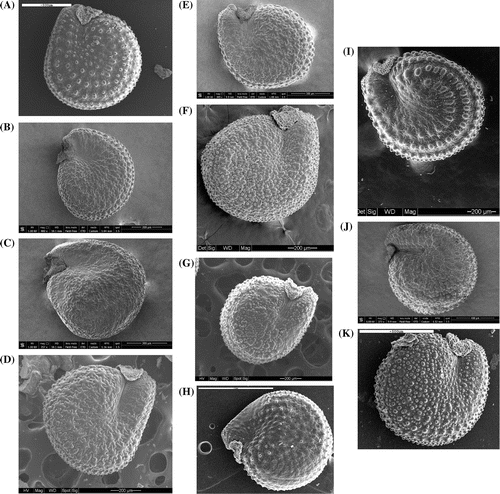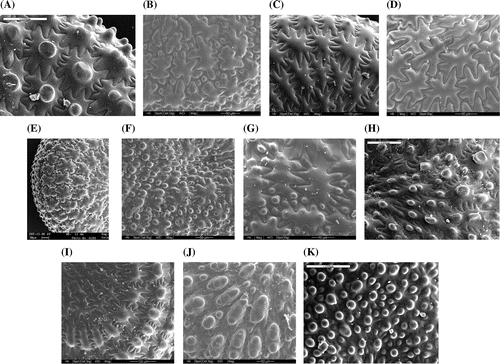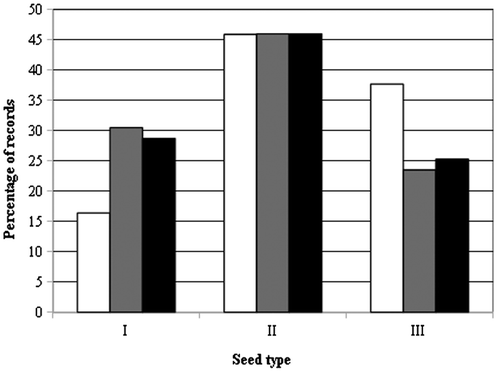Figures & data
Figure 1. Synopsis of the morphotypes of Portulaca oleracea found in the Italian peninsula and surrounding islands. View of the whole seed: (A) ‘P. cypria’, (B) ‘P. granulatostellulata’, (C) ‘P. nitida’, (D) ‘P. oleracea’, (E) ‘P. papillatostellulata’, (F) ‘P. rausii’, (G) ‘P. sardoa’, (H) ‘P. sativa’, (I) ‘P. sicula’, (J) ‘P. trituberculata’, (K) ‘P. zaffranii’. Images (A) and (I) are from Danin, Domina, and Raimondo (Citation2008), modified; images (B), (C), (E) and (J) were taken by Dr Massimo Tonelli; the others are from A. Danin’s personal archive. For images (A) and (K), scale bar is 500 μm; for images (B), (D), (F), (G) and (I), scale bar is 200 μm; for images (C) and (E), scale bar is 300 μm; for image (H), scale bar is 1 mm; for image (J), scale bar is 400 μm.

Figure 2. Synopsis of the morphotypes of Portulaca oleracea found in the Italian peninsula and surrounding islands. Close up of the lateral face of the seed: (A) ‘P. cypria’, (B) ‘P. granulatostellulata’, (C) ‘P. nitida’, (D) ‘P. oleracea’, (E) ‘P. papillatostellulata’, (F) ‘P. rausii’, (G) ‘P. sardoa’, (H) ‘P. sativa’, (I) ‘P. sicula’, (J) ‘P. trituberculata’, (K) ‘P. zaffranii’. Images (A) and (E) are from Danin and Raus (Citation2012), modified; image (H) is from Danin et al. (Citation2014), modified; the others are from A. Danin’s personal archive. For images (A), (H), (I) and (K), scale bar is 100 μm; for images (B), (C), (D), (F) and (J), scale bar is 50 μm; for images (E) and (G), scale bar is 30 μm.

Figure 3. Distribution maps of the Portulaca oleracea morphotypes cited. Their presence is expressed as follows: pale grey, presence attested only in historical herbarium samples (before 1950); dark grey, presence attested both in historical herbarium samples and in recent collections; black, presence attested only in recent collections. (A) ‘P. cypria’, (B) ‘P. granulatostellulata’, (C) ‘P. nitida’, (D) ‘P. oleracea’, (E) ‘P. papillatostellulata’, (F) ‘P. rausii’, (G) ‘P. sardoa’, (H) ‘P. sicula’, (I) ‘P. trituberculata’, (J) ‘P. zaffranii’, (K) Portulaca oleracea f.

Figure 4. Diffusion of the three main seed categories in the samples analysed. White: samples coming from historical herbaria; grey: samples coming from recent collections; black: all the samples considered in this study.

